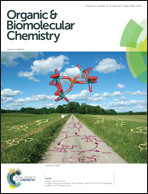A versatile approach for site-directed spin labeling and structural EPR studies of RNAs†
Abstract
Site-directed spin labeling (SDSL) is widely applied for structural studies of biopolymers by electron paramagnetic resonance (EPR). However, SDSL of long RNA sequences still remains a challenging task. Here, we propose a novel SDSL approach potentially suitable for long natural RNAs, which is based on the attachment of a linker containing an aliphatic amino group to the target nucleotide residue followed by selective coupling of a spin label to this amino group. Such a linker can be attached to the desired RNA residue via a sequence-specific reaction with the derivatives of oligodeoxyribonucleotides. To verify this approach, we applied it to model RNA duplex with known structure and expected distance between corresponding residues. A new 2,5-bis(spirocyclohexane)-substituted spin label with advanced stability and relaxation properties has been used, and the distance distribution measured using Q-band (34 GHz) pulsed double electron–electron resonance corresponds well to the expected one. We have additionally validated the obtained results by studying a similar RNA duplex, where the linker with the aliphatic amino group was introduced via solid-phase synthesis. Although this novel SDSL approach does not provide an advantage in precision of molecular distance measurements, we believe that its applicability to long RNAs is a crucial benefit for future structural studies using pulse EPR.


 Please wait while we load your content...
Please wait while we load your content...